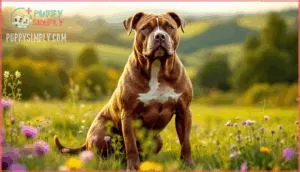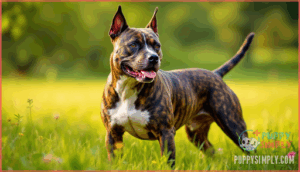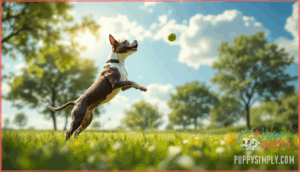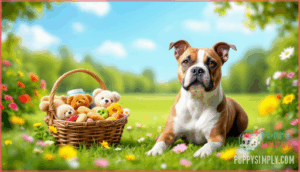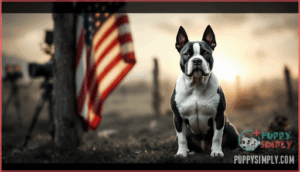This site is supported by our readers. We may earn a commission, at no cost to you, if you purchase through links.
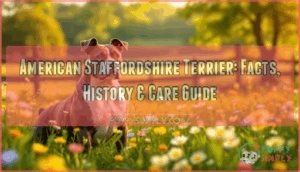
Understanding what separates myth from reality matters because these dogs deserve accurate representation—and potential owners need honest facts to determine if this athletic, intelligent breed matches their lifestyle. From their distinctive physical traits and high-energy temperament to specific training requirements and health considerations, the American Staffordshire Terrier demands informed ownership that goes beyond surface-level assumptions.
Table Of Contents
Key Takeaways
- American Staffordshire Terriers evolved from 19th-century English bull-and-terrier crosses that reached America in the 1850s, where they were selectively bred to become larger farm guardians, war heroes, and loyal family companions before gaining AKC recognition in 1936.
- These muscular dogs require significant daily commitment—at least 60-90 minutes of vigorous exercise, consistent mental stimulation, and early socialization to manage their high energy, strong prey drive, and protective instincts effectively.
- Despite their intimidating appearance, properly trained AmStaffs demonstrate remarkable intelligence, unwavering loyalty to their families, and gentle behavior with children, though they face breed-specific legislation and insurance restrictions based on persistent misconceptions.
- Common health concerns include hip dysplasia (affecting 26% of the breed), heart disease, and skin allergies, making proactive veterinary care, weight management, and life-stage-appropriate nutrition essential for their typical 12-16 year lifespan.
Breed History and Origins
The American Staffordshire Terrier’s story stretches back to early 19th-century England, where bulldogs and terriers were crossed to create a multipurpose working companion.
This breed’s journey from English farms to American recognition involved decades of development and shifting roles.
Understanding where the AmStaff came from helps explain the loyal, athletic dog we see today.
From English Bull-and-Terrier to American Icon
The American Staffordshire Terrier’s roots stretch back to 19th-century England, where breeders mixed bulldogs with English smooth terriers to create powerful "bull-and-terrier" dogs. When these dogs reached American shores in the 1850s, their cultural impact and iconic status grew rapidly:
- Farm families valued them as all-purpose guardians and hunting companions
- American breeders selectively increased their size beyond English counterparts
- Their roles expanded from working dogs to cherished family protectors
This breed evolution transformed them into an enduring symbol of American heritage. The development of the American Staffordshire Terrier is closely tied to dog breeding history.
Recognition and Name Evolution
By the early 20th century, this adaptable breed needed official recognition. The American Kennel Club accepted these dogs for AKC Registration in 1936 under "Staffordshire Terrier," marking a landmark in Breed Standardization. The Name Evolution continued when, in 1972, the breed became the American Staffordshire Terrier—a change reflecting its heavier American build and distinguishing it from Britain’s Staffordshire Bull Terrier. Understanding the breed’s genetic health is essential for responsible ownership.
| Year | Recognition Milestone |
|---|---|
| 1936 | AKC accepts breed as "Staffordshire Terrier" |
| 1954 | International kennel clubs grant recognition |
| 1960s | Registration rules tighten for purebred status |
| 1972 | Official name becomes "American Staffordshire Terrier" |
This Recognition History shaped the AmStaff’s identity as a show and companion dog rather than a working fighter.
Working Roles on Farms and Beyond
Once these dogs stepped off the show floor, their real work began—on American farms, they tracked down rats, guarded property, and even helped move livestock with fearless determination. Their intelligence and athleticism made them naturals at Rodent Control and Livestock Guarding.
Today, this breed’s courage shines in Search Rescue missions and Therapy Work, proving the American Staffordshire Terrier’s adaptability extends far beyond its historical roots in Farm Work.
Physical Characteristics and Appearance
The American Staffordshire Terrier’s appearance is striking and unmistakable. From their stocky, muscular build to their broad heads and powerful jaws, these dogs are built for strength and athleticism.
Let’s look at the key physical traits that define this impressive breed.
Size and Build Standards
You’ll notice AmStaffs pack serious muscle structure into a compact frame—males stand 18 to 19 inches at the shoulder, females 17 to 18 inches. Despite their modest height, these muscular breeds clock in at 55 to 70 pounds for males and 40 to 55 pounds for females.
Breed standards emphasize body proportions that balance a broad chest with athletic hindquarters, giving them that signature low center of gravity. Growth patterns show rapid development, with full physical maturity around 18 to 24 months. Weight management matters since proper nutrition sustains their dense muscle structure throughout life.
Coat Colors and Texture
Your AmStaff’s coat tells a colorful story—breed standards welcome everything from solid hues to patched patterns, though all-white, more than 80% white, black-and-tan, or liver colors don’t meet show requirements.
The texture types you’ll encounter include:
- Stiff and glossy coat that lies flat against muscular contours
- Short, smooth texture requiring minimal grooming effort
- Low shedding rates that make maintenance straightforward
Color genetics create endless combinations, from brindle to blue to fawn, each showcasing the American Staffordshire Terrier’s physical traits beautifully.
Distinctive Facial Features and Jaw Structure
The American Staffordshire Terrier’s face makes an unforgettable first impression—a broad skull that tapers slightly toward a powerful muzzle, creating the balanced proportion breeders have refined over generations. Round, dark eyes sit low in the skull, giving your AmStaff an alert, intelligent expression. Well-defined cheekbones frame strong teeth that meet in a proper scissor bite, while jaw alignment contributes to the breed’s notable bite force.
| Facial Feature | Characteristic | Functional Purpose |
|---|---|---|
| Skull Shape | Broad, medium-length | Anchors powerful jaw muscles |
| Jaw Structure | Well-defined, muscular | Generates significant bite force |
| Teeth Formation | Strong, scissor bite | Effective grip and hold |
| Cheekbones | Prominent, refined | Frames facial structure |
Temperament and Personality Traits
Understanding an American Staffordshire Terrier’s temperament helps you know what to expect before bringing one home. These dogs have distinct personality traits shaped by their history and breeding.
Let’s look at three key aspects that define how AmStaffs think, feel, and behave.
Intelligence and Trainability
Regarding intelligence, these dogs don’t just follow commands—they actively problem-solve their way through challenges. American Staffordshire Terriers excel in obedience training and agility performance because their cognitive development thrives on learning strategies that keep them engaged.
You’ll find this breed highly trainable, mastering canine behavior and training concepts quickly when given consistent mental stimulation. Their eagerness to please makes dog training rewarding, though they need clear boundaries to channel their sharp minds productively.
Loyalty and Protective Instincts
When you earn an American Staffordshire Terrier’s trust, you’ve gained a companion who’ll stand by you with unwavering devotion—these dogs form deep emotional bonds that transform them into natural guardians of their families.
Earn an American Staffordshire Terrier’s trust, and you’ve gained a devoted guardian who stands by you with unwavering loyalty
Their loyalty and protection instincts emerge through:
- Vigilant monitoring of household activity
- Immediate response to perceived threats
- Calm assessment before defensive action
- Fierce courage when family safety demands it
This breed’s guard dog traits and pack dynamics mean they’re naturally protective without unnecessary aggression, making them reliable guard dogs when properly socialized.
Energy Levels and Play Drive
If you think your AmStaff will settle for a leisurely stroll around the block, think again—this breed brings the kind of boundless energy and play drive that turns every day into an athletic event. Their exercise routine demands commitment: your American Staffordshire Terrier needs at least 60-90 minutes of vigorous physical activity daily to channel their high energy level into healthy outlets.
| Activity Requirements | Daily Minimum |
|---|---|
| Vigorous Exercise | 60-90 minutes |
| Mental Stimulation | 20-30 minutes |
| Interactive Play Sessions | 2-3 times |
Their playful nature shines through fetch games, tug-of-war, and agility courses—activities that satisfy both their physical demands and sharp minds, preventing the destructive behaviors that emerge when these intelligent athletes get bored.
Training and Socialization Requirements
Training your American Staffordshire Terrier isn’t just about teaching commands—it’s about shaping a confident, well-adjusted companion who can manage the world around them. These intelligent dogs need structure from day one, along with plenty of opportunities to burn energy and engage their minds.
Let’s look at the key areas you’ll want to focus on to set your AmStaff up for success.
Early Socialization Strategies
Starting socialization the day your AmStaff puppy comes home isn’t just important—it’s the foundation for everything your dog will become. Puppy socialization means exposing your dog to different people, animals, sounds, and environments in positive ways.
Watch canine body language carefully—relaxed postures signal comfort, while stiff movements suggest stress. Breed-specific training acknowledges that American Staffordshire Terrier socialization requires patience and consistency to build confidence and prevent fear-based reactions later.
Mental Stimulation and Physical Challenges
Once you’ve got socialization down, your AmStaff’s sharp mind and athletic body need regular workouts to stay happy and out of trouble. Consider these effective approaches:
- Dog sports like agility training and dock diving channel their natural athleticism
- Mental exercises including puzzle toys and scent work prevent boredom
- Play activities that combine physical conditioning with canine sports engagement
American Staffordshire Terrier exercise requirements are high—without proper outlets, you’ll see destructive behaviors emerge quickly.
Managing Prey Drive and Dog Aggression
Even with plenty of exercise, your AmStaff’s terrier instincts can kick in around small animals or unfamiliar dogs, so you’ll need to stay one step ahead with training and management. Learning canine body language helps you recognize aggression triggers before situations escalate. Understanding the difference between prey drive management and fear-based aggression lets you apply the right intervention—whether that’s redirecting attention or creating distance.
| Trigger Type | Warning Signs | Management Strategy |
|---|---|---|
| Prey Drive | Intense staring, stiffening, focused attention on small animals | Use "leave it" command, leashed walks, controlled exposure |
| Dog Aggression | Raised hackles, hard eye contact, forward body posture | Early socialization, neutral territory introductions, professional training |
| Redirected Aggression | Sudden trigger shifts focus toward nearby person or animal | Avoid tight leashes during high-arousal moments, teach "look at me" cue |
Health, Nutrition, and Care Needs
Your American Staffordshire Terrier’s well-being depends on staying ahead of potential health concerns, feeding the right foods at the right time, and keeping up with basic care routines. Understanding these essentials helps you catch problems early and keeps your dog feeling their best.
Let’s break down what you need to know about managing health, nutrition, and daily maintenance.
Common Health Issues and Prevention
Understanding American Staffordshire Terrier health problems helps you protect your companion for years to come. This breed faces several genetic health conditions and canine health issues that require proactive monitoring. Hip dysplasia affects roughly 26% of AmStaffs, while heart disease, skin allergies, obesity risks, and neuronal decline linked to NCL also deserve attention.
Here’s what matters most:
- Hip dysplasia usually appears before age 2, so maintain healthy weight and exercise routines early
- Heart disease screening through annual echocardiograms catches dilated cardiomyopathy before symptoms emerge
- Skin allergies often trigger secondary infections, making regular vet checks and medicated baths essential prevention tools
Dietary Requirements by Life Stage
Your AmStaff’s American Staffordshire Terrier nutrition shifts dramatically through life. Puppy Nutrition demands 25–30% protein and 4 meals daily from 2–3 months, supporting rapid growth. Adult Feeding drops to 2 meals with 22–28% protein and 1,800–2,400 Caloric Intake based on activity. Senior Diets emphasize Nutrient Balance with joint-supporting omega-3s and higher fiber for digestive health.
| Life Stage | Daily Calories | Protein % | Fat % | Meal Frequency |
|---|---|---|---|---|
| Puppy (2–12 mo) | Varies by weight | 25–30% | 15–20% | 3–4 times |
| Adult (1–7 yrs) | 1,800–2,400 | 22–28% | 10–15% | 2 times |
| Senior (7+ yrs) | Reduced intake | 22–28% | 10–12% | 2 times |
Canine nutrition isn’t one-size-fits-all—monitor body condition and adjust portions as your dog’s health changes.
Grooming and Maintenance Routines
Your AmStaff’s grooming demands are surprisingly light—a quick weekly brush and monthly bath keep that sleek coat gleaming without the fuss of high-maintenance breeds.
Nail Trimming requires weekly attention since nails grow fast, while Dental Hygiene needs at-home brushing and professional cleanings to prevent disease.
Shedding Control stays manageable with a rubber curry brush or Grooming Tools designed for short coats, making American Staffordshire Terrier grooming straightforward for busy owners.
Notable American Staffordshire Terriers in History
American Staffordshire Terriers have left their paw prints throughout history, from battlefields to Hollywood sets. These dogs proved their courage, loyalty, and adaptability in ways that captured public attention and earned them lasting recognition.
Here’s a look at some of the most famous AmStaffs who made their mark on the world.
War Heroes: Stubby and Sallie
Two American Staffordshire Terriers stand out in War Dog History for their outstanding Canine Courage. Sergeant Stubby served 18 months in World War I, detecting mustard gas attacks and capturing a German spy—earning him the first battlefield promotion given to a dog.
Sallie, a Civil War Military Mascot with the 11th Pennsylvania Infantry, demonstrated impressive Dog Loyalty by refusing to leave wounded soldiers at Gettysburg, where she guarded them for three days before being found.
Entertainment Icons: Petey and Tige
Before war heroes like Stubby and Sallie captured hearts on the battlefield, American Staffordshire Terriers were already winning over audiences on the silver screen and in popular advertising. Petey, the ring-eyed pup from "Our Gang" films in the 1930s, became one of the most recognizable Celebrity Dogs of his era. His Film Careers showcased the breed’s gentle nature with children, shifting public perception. Meanwhile, Tige modeled for Buster Brown Shoes, cementing the AmStaff’s Cultural Significance in American households.
Modern Media Appearances
Today’s American Staffordshire Terriers continue their Hollywood legacy, appearing in shows like "The Good Doctor" and films such as "The Predator," proving this breed’s screen presence never really faded.
These TV appearances have shifted media portrayal markedly, highlighting the AmStaff’s range beyond outdated stereotypes. Celebrity owners and positive film roles continue reshaping public perception, showing audiences the loyal, intelligent companion behind the muscular build—a far cry from the Pitbull Terrier misconceptions that once dominated headlines.
Frequently Asked Questions (FAQs)
What is the typical lifespan of AmStaffs?
Regarding the American Staffordshire Terrier’s health and longevity, these dogs usually live the long haul—averaging 12 to 16 years.
Lifespan factors include diet impact, age-related health issues, and consistent veterinary care, making longevity tips essential for American Staffordshire Terrier care.
Are AmStaffs good with children and families?
With proper socialization and parental guidance, American Staffordshire Terriers can be excellent family dogs who form strong bonds with children.
Their loyal temperament and protective instincts shine in a stable household environment, though supervision during interactions guarantees child safety.
Do American Staffordshire Terriers require a lot of exercise?
Yes, American Staffordshire Terriers require substantial daily exercise to stay healthy and content. Plan for at least an hour of physical activity through walks, play sessions, and dog sports to meet their fitness levels and prevent boredom-related behaviors.
What are breed-specific legislation concerns for AmStaffs?
Ironically, American Staffordshire Terriers face breed discrimination through bans or restrictions despite their breed history and development as loyal companions.
Liability laws may require expensive insurance coverage , while insurance issues and public perception about Pit Bull Terrier breeds create ownership rights challenges across jurisdictions.
How do AmStaffs differ from Pit Bulls?
The American Staffordshire Terrier is a recognized breed with specific standards, while "Pit Bull" is an umbrella term covering several bully breeds, including AmStaffs.
These breeds share overlapping genetics but exhibit distinct physical distinctions and behavioral traits shaped by their historical context.
Conclusion
Understanding this breed isn’t just about reading the stats—it’s about seeing past the stereotypes. The American Staffordshire Terrier won’t fit every household, but for owners who embrace their energy, intelligence, and loyalty, these dogs prove that important information as well as facts about American Staffordshire Terrier reveal a breed built on devotion, not danger.
With proper training, socialization, and commitment, you’ll discover a companion whose heart matches their powerful frame.
- https://en.wikipedia.org/wiki/American_Staffordshire_Terrier
- https://www.petmd.com/dog/breeds/american-staffordshire-terrier
- https://thepetlabco.com/learn/dog/health-wellness/american-staffordshire-terrier-lifespan
- https://www.pitbullinfo.org/pit-bulls-temperament-scores
- https://pets.webmd.com/dogs/ss/slideshow-long-living-dog-breeds

